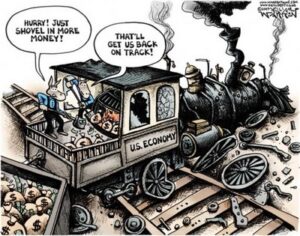
The answer may be that’s how economist Simon Kuznets, who developed the measure, saw things. In his 1934 report “Report on National Income” to Congress, he acknowledged there might be skepticism over its inclusion in the measure.
“There may be some doubt as to the propriety of classifying government (Federal, State, county and city) as a branch of the country’s economic system, and of treating its activity as an economic pursuit,” Kuznets wrote, adding, “the motive of immediate profit, which characterizes private industry, is conspicuously absent from the activity of the government.”
On the other hand, he wrote, “purely governmental functions are of real value in the economic life of the nation, and that they give rise to income which should be taken into account.”
Essentially, because the government spends money, generating income for government employees and contractors, which results in further consumption, it affects the economy. As such, Kuznets included it as a component of the GDP.
Simple enough. Fast forward eighty years, however, and it appears this inclusion by Kuznets has had some unintended consequences.
Namely, it has led to the development of the view, largely in the Keynesian school of economics, that government spending, because it nominally boosts GDP when it is increased, should therefore always be increased.
One such advocate currently resides in the White House: Barack Obama.
In a Feb. 5 press briefing advocating for Congress to again delay implementation of some $53.8 billion of sequestration cuts to outlays due on March 1, Obama suggested that “we can’t just cut our way to prosperity.”
Obama continued, “Deep, indiscriminate cuts to things like education and training, energy and national security will cost us jobs, and it will slow down our recovery. It’s not the right thing to do for the economy.”
This followed the White House’s explanation for the 0.1 percent contraction of the economy in the fourth quarter as coming on account of a $40.4 billion overall cut to government spending explained the contraction. On Jan. 30, White House Press Secretary Jay Carney opined, “the GDP number we saw today was driven in part by — in large part by a sharp decrease in defense spending.”
Americans for Limited Government President Bill Wilson acknowledged this in a recent piece, “The Fed can’t print growth,” writing that this type of result “probably advises why government spending should no longer be included in the measurement of growth. How much money the government wastes every quarter really tells us nothing about the health of the private economy anyway.”
Wilson noted that if government spending had been excluded as a component of GDP, in the fourth quarter of 2012 the private sector only grew by a 1.3 percent real rate. “That is nothing to write home about,” he said. In other words, even without the spending cuts, the underlying economy is still very weak.
Underscoring his point on the misleading impact government spending has on GDP, he looked back at the economic impact of decreased government spending after World War II: “GDP contracted by 1.1 percent in 1945, by a whopping 10.9 percent 1946, and then again in 1947 by 0.9 percent. Meanwhile, personal consumption and private investment was increasing substantially after the war ended.”
Wilson is correct. In 1946 alone, even though personal consumption jumped 12.4 percent and private investment 156.4 percent, because bloated government spending dropped by 65.6 percent, the economy “shrank” by 10.9 percent.
“Was the economy contracting, or was spending simply cut?” Wilson asked.
He explained, “The fact is, the war ending and the substantial decrease of government spending were both boons for the global economy, which after the war the economy grew dramatically,” such that “including spending as a component of GDP is a gross distortion of economic reports.”
Adjunct scholar of the Mises Institute Howard Shostak succinctly points to the potential absurdity of using government spending to measure economic welfare, writing, “if a government embarks on the building of a pyramid, which adds absolutely nothing to the well-being of individuals, the GDP framework will regard this as economic growth.”
Shostak makes a fair point. Without distinction, government spending, whether or not it is wasteful, tends to get lumped together with everything else. Moreover, government spending may even be disruptive and economically counterproductive.
Shostak notes that “the building of the pyramid will divert real funding from wealth-generating activities, thereby stifling the production of wealth.”
That certainly appears to have been the experience after World War II. Once resources previously dedicated to the war effort were freed up, the private sector economy grew rapidly.
To that end, Wilson advocated for the government to get out of the way, concluding, “the budget should be balanced, freeing up resources for the private sector. Health, labor, and environmental regulations restricting business expansion ought to be rolled back. And sound money must be restored, bringing an end to the Fed’s quantitative easing programs.”
Instead, the only thing Obama appears interested in is increasing spending.
Robert Romano is the Senior Editor of Americans for Limited Government.






